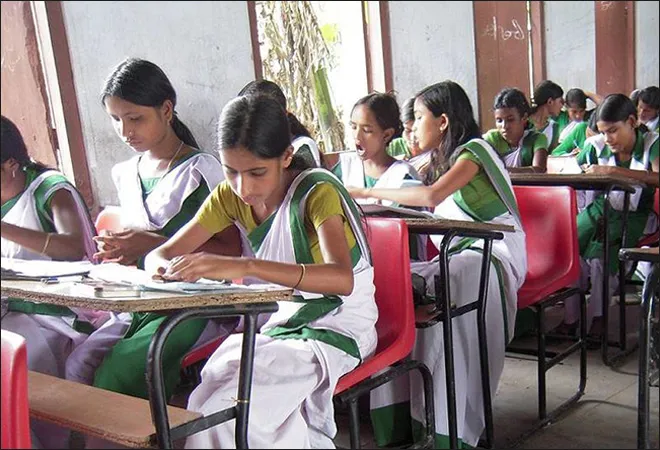-
CENTRES
Progammes & Centres
Location

In a world that is becoming increasingly inward looking and parochial, understanding the need for equal opportunities for all and empowering those discriminated against on the basis of gender is vital. Social conditioning across the globe since centuries has conditioned men to believe that they are superior. Surprisingly, it has also successfully conditioned a majority of both men as well as women into believing that the latter is the ‘second’ sex – where men are the default, while women are the ‘other’.
The range of gender-based inequality in India can be measured by examining two important statistics:
Of India’s 422 million-strong youth population, the total enrolment in higher education has been estimated to be 34.6 million per annum. Given this scenario, educational institutions provide an opportunity to influence large numbers of youngsters. As stated by Emma Watson, Global Goodwill Ambassador of UN Women, “universities are tiny utopias, a miniature model of how the whole society could look.”
‘Gender Sensitisation’ in higher education finds a mention in the ‘Draft National Policy for Women - 2016’ and it also forms an important recommendation of ‘Saksham’ – Measures for ensuring the Safety of Women and Programmes for Gender Sensitisation on Campuses’ report released by the University Grants Commission (UGC) in 2013.
Gender sensitisation addresses a range of problems such as citizenship and rights, countering sexual harassment and issues of equality and freedom, questions of sexuality, norms of masculinity and femininity, and the understanding and respect towards all who contribute to the diverse and heterogeneous composition of college and university campuses.
The Saksham guidelines state that “Making a course compulsory would ensure that all students are exposed to a longer pedagogic engagement with issues of gender and related issues of inequality, but it could also lead to resistance and resentment and vitiate the very purpose for which it has been created.” In the same guidelines, it is also mentioned that “students pointed out that the terms “women” and “gender”, if used without due care, led to homogenisation and could be problematic”.
The solution to combat this is to subtly include gender-related issues as a part of existing curriculum, instead of a whole subject on the inequalities and problems faced by women. Context-specific problems that put one gender at a disadvantage should be spoken about rather than making a forced conversation on the perils of patriarchy, imbalance in opportunities and the curtailment of freedom that stems from gender inequality.
Incorporating realistic and relevant examples on the presence of the ‘glass ceiling’ or the ‘maternal wall’ and how these situations hamper professional growth for women, should be considered through various components in existing subjects.
Management education can have case-studies devoted to the gender pay gap, students of hotel management and journalism could be made to discuss the impact of late-night shifts for women and the safety concerns that they bring and engineering courses should highlight the lower percentage of women students in their batch, and discuss how professions have been stereotyped as per gender.
Another effective method to bring about gender sensitisation is making all communication gender-neutral by using equal proportions of feminine and masculine personal pronouns. The ‘Antwerp Charter on Gender – Sensitive Communication In and By Academic Institutions’ also mentions this, whereby signatories commit to “promoting gender-sensitive communication through eliminating gender stereotypes and using multidimensional representations of women and men”.
This charter also requires its signatories to commit to “Promoting the unbiased portrayal of women and men through a balanced presence in communication”. This, it says, can be done by giving equal importance to women achievers and leaders across various segments of the society. Instead of labelling women as victims of patriarchy, curriculum designers should enumerate their success stories just like the stories of their male counterparts.
Most professional courses have a component of personality development, while gender-related topics are included as the subject of various activities such as group discussions, debates, public speaking, etc. These are half-hearted attempts, which do not effectively translate into structured information dissemination. Faculty members need to add to the perspectives that emerge out of these discussions and ensure that the nuances of gender and the need for equality are communicated in the right manner.
Workshops and seminars conducted in an innovative and interactive fashion can be valuable in aiding the process of sensitisation provided that their frequency is increased. The usual system of conducting workshops in the gap of quarterly or half-yearly timelines will not be able to generate the necessary impact.
Women’s Studies Centres or Women’s Development Cells in universities and colleges are major facilitators in the process of encouraging women’s equality through gender sensitisation. Instead of focusing primarily on prevention of sexual harassment on campus, these centres should help in promoting various other methods of gender sensitisation. An unconventional approach to these development cells has been undertaken by the Stony Brook University through their Center for the Study of Men and Masculinities (CSMM), which aims to engage men into the conversation to help embed gender into the curriculum by supporting research that furthers the development of boys and men in the service of healthy masculinities and greater gender equality
The ‘HeforShe impact 10x10x10 - University parity report 2016’, shares two very interesting methods of combating gender inequality on campus, as a part of their impact commitments. The first one is to increasing the representation of women in senior leadership positions as even though women make up a larger proportion of higher educators as compared to men, only a handful reach senior roles. This step is important because gender equality in administration will allow key decision makers to develop stronger gender-responsive policies and to mainstream this priority throughout all levels of management.
The second one is to close the gender gap in academics by breaking stereotypes and encourage women to take up education in science and technology. This will determine their future career paths and the disparity in STEM based career roles shall be addressed.
A very essential component of gender sensitisation is the mandatory knowledge of legal literacy on the rights of women and the various laws for prevention against harassment such as the Prevention of Sexual Harassment at Work (POSH) Guidelines, the Prevention of Sexual Harassment at the Workplace Act 2013, the Criminal Law Amendment Act 2013 and the Bill of Rights for Women in the Justice Verma Committee report, to name a few. It is imperative that these are made a compulsory part of the syllabus across various courses in higher education.
Robert Zoellick, the eleventh president of the World Bank, said, “Equality is not just the right thing to do. It’s smart economics. How can an economy achieve full potential if it ignores, sidelines, or fails to invest in half its population?” Gender equality in higher education will eventually lead to an economy that thrives due to the increased availability of skilled and talented human resources.
Universities comprise of a heterogeneous population, all of whom need to be represented adequately. The methods mentioned above do not require radical changes; they are simple yet effective measures and can be tweaked to incorporate a gender-neutral approach to accommodate all orientations with ease. This will ensure that we move ahead from the phase of discussion and reach the phase of implementation in order to achieve equality for all.
The views expressed above belong to the author(s). ORF research and analyses now available on Telegram! Click here to access our curated content — blogs, longforms and interviews.

Ami Pandya was Associate Fellow and New Media Manager at Observer Research Foundation Mumbai. She worked with the communication and outreach team in making research ...
Read More +